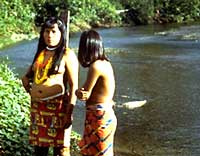
The Secrets of the Choco 1995
Distributed by Bullfrog Films, PO Box 149, Oley, PA 19547; 800-543-FROG (3764)
Productions Grand du Nord Quebec Inc.
Directed by Ian McLaren
VHS, color, 52 min.
Jr. High - Adult
Anthropology
Date Entered: 11/09/2018
Reviewed by Rebecca Graves, J. Otto Lottes Health Sciences Library, University of Missouri - Columbia.On the eve of the twenty-first century, it is difficult to imagine that places exist that are yet to be explored. Ian McLaren takes us to such a place in the Secrets of the Choco. Located on the Pacific coast of Colombia, and extending inland to the Andes mountains, the Choco is one of the largest, fairly pristine rainforests on earth. Although inhabited, there is little knowledge (on the part of non-inhabitants) of the plants, animals, and insects that live in the region. Here there exists many species which either have died out elsewhere or are unique to the Choco. The humans which share this environment are mainly blacks or indigenous peoples. While most live in poverty, they are able to sustain themselves off of the bounty of the rainforest.
McLaren takes us into the Choco, in the company of scientists and environmentalists, aboard the steamer the Jestiven. When the rivers become too shallow they transfer to fishing boats in order to reach their inland destination where they will study the flora and fauna and meet with the people who are working to claim the land for their own. While some of the images are stereotypical of what westerners might consider a traditional life style, many are not. We are witness to meetings with advocates and villagers who are working to build coalitions that block development imposed from outside forces, as well as interviews with well spoken individuals who disbelieve the claim that the corporations pushing to develop the area will in reality benefit the local inhabitants.
Logging, tourism, and ranching are examples of the industries interested in the area. Already, areas are being logged for the timber, threatening one of the few if not the only existing rainforest that extends into the sea. The idea that a tree is only value when processed into lumber is contrasted with its value as part of an ecological system, providing food and shelter for animals as well as preventing erosion among other functions. With its pristine beaches, the Choco is seen as a natural place for tourism. Yet even with eco-tourism, how does one balance the demands of the tourists without destroying the environment that they have come to see? Ranching is also threatening the Choco. Large tracts are cut down to make way for herds of cattle which can only be supported for 2 to 3 years on the rainforest soil. Then they must be moved to a new pasture requiring the destruction of yet more forest. The idea of appropriate farming methods is raised with the point being made that methods workable in temperate climates are not transferable to tropical ones.
In this well made documentary, McLaren raises many questions about the Choco, such as how to preserve the rainforest yet increase the standard of living for its inhabitants, how to balance the demands for development with the rights of the indigenous inhabitants and with the needs of the environment. Winner of the Golden Sheaf Awards, Best Science & Nature, at the Yorkton Film Festival, the Secrets of The Choco is well worth watching. Appropriate for junior high through university, it would be of interest to students in courses on social studies, anthropology, political science, economics, and geography.